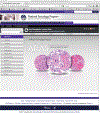The National Toxicology Program Web-based nonneoplastic lesion atlas: a global toxicology and pathology resource
- PMID: 24488020
- PMCID: PMC6880752
- DOI: 10.1177/0192623313517304
The National Toxicology Program Web-based nonneoplastic lesion atlas: a global toxicology and pathology resource
Abstract
Toxicologists and pathologists worldwide will benefit from a new, website-based, and completely searchable Nonneoplastic Lesion Atlas just released by the U.S. National Toxicology Program (NTP). The atlas is a much-needed resource with thousands of high-quality, zoomable images and diagnostic guidelines for each rodent lesion. Liver, gallbladder, nervous system, bone marrow, lower urinary tract and skin lesion images, and diagnostic strategies are available now. More organ and biological systems will be added with a total of 22 chapters planned for the completed project. The atlas will be used by the NTP and its many pathology partners to standardize lesion diagnosis, terminology, and the way lesions are recorded. The goal is to improve our understanding of nonneoplastic lesions and the consistency and accuracy of their diagnosis between pathologists and laboratories. The atlas is also a useful training tool for pathology residents and can be used to bolster any organization's own lesion databases. Researchers have free access to this online resource at www.ntp.niehs.nih.gov/nonneoplastic.
Keywords: NTP; National Toxicology Program; atlas; nonneoplastic lesion; toxicologic pathology..
Figures
References
-
- Beckett WS. (2000). Occupational respiratory diseases. N Engl J Med 342:406–13. - PubMed
-
- Langrish JP, Bosson J, Unosson J, Muala A, Newby DE, Mills NL, Blomberg A, Sandström T. (2012). Cardiovascular effects of particulate air pollution exposure: Time course and underlying mechanisms. J Intern Med 272:224–39. - PubMed
-
- Mann PC, Vahle J, Keenan CM, Baker JF, Bradley AE, Goodman DG, Harada T, Herbert R, Kaufman W, Kellner R, Nolte T, Rittinghausen S, Tanaka T. (2012). International Harmonization of Toxicologic Pathology Nomenclature: An overview and review of basic principles. Toxicol Pathol 40:7S–13S. - PubMed
MeSH terms
Grants and funding
LinkOut - more resources
Full Text Sources
Other Literature Sources


